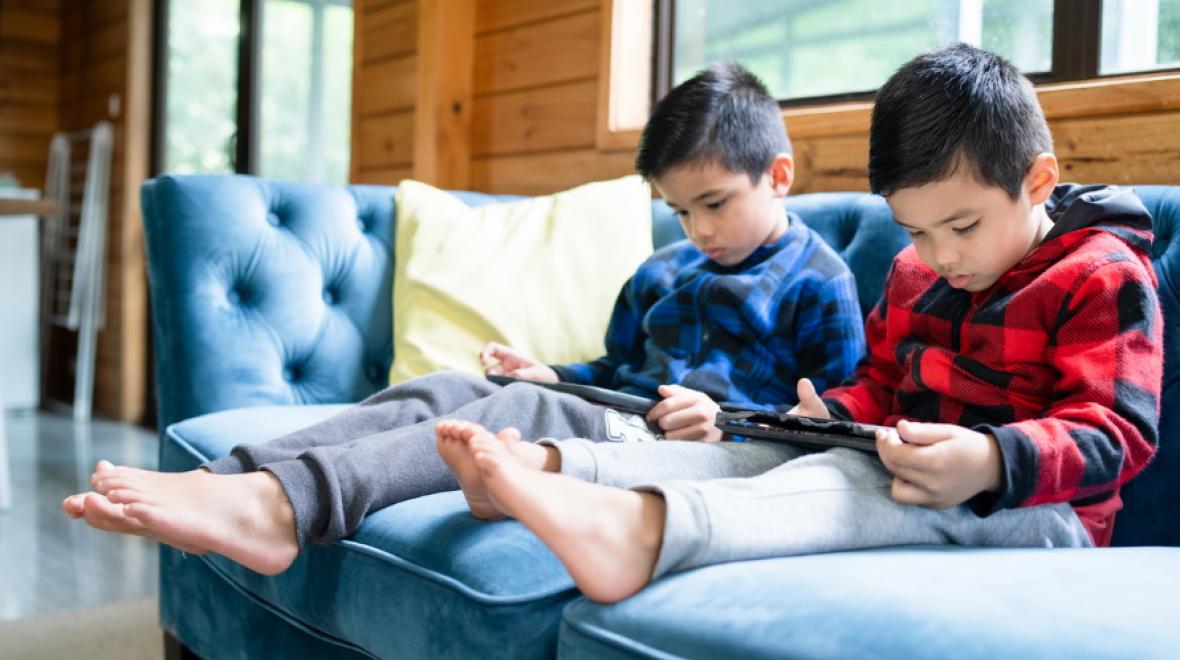
Like any technology, electronic devices are a mixed bag of benefits and downsides. While they do offer an endless world of educational resources, their overuse may harm your child’s cognitive health. For example, one recent study found too much screen time shortens the attention spans of teenagers. And for children on the autism spectrum, digital devices may also interrupt valuable “quiet time.” Apps, games, ads and videos can become an overwhelming cacophony of sights and sounds. Too much can overstimulate the senses and raise anxiety levels.
Childhood experts are also concerned about the physical and behavioral effects of screen time. Digital experiences often replace opportunities for physical exercise and face-to-face communications. The loss of these opportunities can affect your child’s physical health and socialization.
But not all is lost. When practiced in moderation, screen time can be a healthy addition to your child’s daily diet of play. Here are seven tips for managing screen time and keeping your kids healthy.
Choose high-quality content.
If you’re using digital media to educate and entertain your children, find the highest quality content available. Online sources like Common Sense Media provide recommendations and reviews on animated series, movies, learning apps and e-books. Childhood experts also regard PBS shows like “Sesame Workshop” or “Dinosaur Train” as high-quality digital content for children.
Children and teens also benefit from watching social and nature documentaries. Try subscribing to a curated documentary streaming service. Watching documentaries with your child is a great way to learn together. Be mindful that many of these streaming services do not have parental controls. So watching with your child is a great way to know what they’re consuming.
Don’t introduce digital devices too early.
Children learn the most within the first three years of their lives. In that time, they acquire language skills, spatial reasoning, and interpersonal communication through trial and error. They need all five senses engaged to learn effectively. But digital screens can get between this process by limiting interaction to only hearing and seeing. Toddlers can’t grasp objects, manipulate them or view outcomes through digital screens. The experience is akin to watching someone fish rather than fishing yourself — there’s no direct feedback for learning.
When digital media completely replaces hands-on experience, children no longer receive the level of intellectual challenge they need. That’s why the American Academy of Pediatrics (AAP) recommends children younger than 18 months avoid using screen media.
Create a screen time schedule.
Creating a screen time schedule will ensure you’re including a healthy mixture of activities for your child. Plus, it makes screen time predictable. But first create a family media plan to find your appropriate level of media use. Your digital media use will be specific to your family. Some families may need more screen time for homeschooling. Others may need less because they have more access to physical resources like parks and museums. Whatever your level, include a variety of interactive activities.
Limit screen time to moments when social interactions are less likely. For example, have your child watch a video while you’re taking a shower or cooking dinner. If possible, combine the media with what you’re doing. For example, have your child read out loud an online recipe for the meal you’re preparing. Using digital media in conjunction with real-life activities puts it in a useful context, not just as a source of entertainment.
Use timers and parental controls.
Use a timer to stick to your screen time schedule and to monitor device use. Set a cooking timer or digital alarm on your smartphone to let your child know when screen time is over. Or use your device’s screen time controls. These features let you monitor and control when specific apps are available and for how long. Once time limits are reached, the device cuts off access.
Avoid screen time before bedtime.
Children on the spectrum tend to have lower levels of melatonin and more sleep disturbances. So, it’s critical to restrict digital device use at least an hour before bedtime. Video games and movies keep your child’s emotions and cognitive activity highly engaged. That’s beneficial when they’re playing puzzle games or watching cartoons. But it makes falling to sleep much harder.
Lower melatonin levels make regulating our internal clocks (i.e. circadian rhythms) difficult. And the blue light emitted from most digital screens tells our brains the sun is still up, even when it’s not. If your child’s device includes a color shift feature (e.g. Apple’s “Night Shift”), turn it on. It will automatically shift the color of the device’s screen from blue to a yellow at sunset. The color shift will interfere less with your child’s circadian rhythm and help them fall asleep faster.
Model good screen time behavior.
The best way to instill healthy digital media use for your children is to model good habits. Institute a “no device” policy for specific times like at meals and before bedtime. And stick to it. Monitor your own digital use with a screen time monitoring app. Ask yourself tough questions like:
- Is my media use causing me to ignore my child?
- How soon do I check my phone after waking up?
- Am I putting in more time checking social media than spending with my family?
- Could I be addicted to my smartphone?
These are questions you would want your children to consider. So, ask them of yourself too. And be honest. Your children are watching how you consume media. They will take the habits you teach them into their adult lives.
Use analog alternatives to digital media.
There were ways to learn and have fun before the internet and smartphones. Consider analog alternatives and substitute them for screen time. Drawing on paper, painting on canvas and sculpting from clay are good alternatives. Writing, journaling and scrapbooking are entertaining and educational options. Or get out into nature by visiting a zoo or going for a hike. There’s hardly anything offered on a digital screen that’s not also available in physical form.
Today, digital devices and the internet are indispensable for transferring information and connecting with others. Children need to know how to navigate and interface with them to participate in an ever-changing culture. Screen time helps them acquire these skills. So, give your child screen time, but set realistic expectations. Emphasize that digital devices are helpful tools, but don’t elevate them above other priorities. And when you choose media, don’t skimp—too much of anything is bad, but too much of a bad thing is worse.
Editor's Note: This article was originally published on Autism Parenting Magazine and republished with permission.











